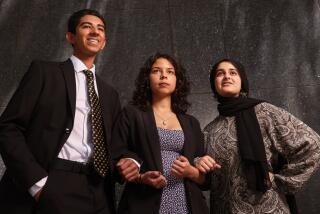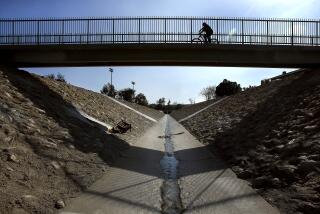He Fights So Your Next Breath Won’t Make You Sick
TUCSON — From his bedroom, Alan Bell walks stiffly down a long tiled hallway, through the unfurnished living room, dining room and den and on into his office.
Then he turns around and walks back.
This is the only exercise Bell, a former runner, weightlifter and racquetball player, will get today--or tomorrow, or the day after that.
Four years ago, he was found to have Chronic Fatigue Immune Dysfunction Syndrome, a condition he traces to contact with toxic chemicals while growing up in south Florida. Exposure to even minute amounts of chemicals or pollen triggers a host of agonizing symptoms.
Trying to live as free from synthetic chemicals as he can, Bell effectively is a prisoner in his own home.
But the illness that robbed him of his health and freedom also spurred the 41-year-old lawyer to action. In 1993, Bell and his younger brother, Robert, founded the Environmental Health Foundation, which is dedicated to research and raising public awareness of environmentally related diseases.
“The foundation is focusing on mainstream problems facing the masses,” Alan Bell says. “My particular problem is not an issue. It was merely a catalyst that forced me to open up my eyes.”
Tall and sandy-haired, Bell is a man with a mission. He reels off statistics regarding environmentally linked diseases with practiced ease: One of six preschoolers has dangerously high lead concentrations; indoor air pollution affects 75 million Americans; one in 20 deaths in cities is linked to air pollution; levels of cancer, childhood asthma and Parkinson’s disease are rising dramatically.
He asks, “With all the billions we’re putting into research, why is the incidence of all these diseases rising?”
Bell started the Environmental Health Foundation to “look at how all these diseases are interrelated to common, ordinary factors.”
*
Little in Bell’s background would have suggested a future career as an environmental crusader.
Born in New York City, he was raised in Miami, where he attended college and law school at the University of Miami.
As a prosecutor in Fort Lauderdale from 1980 to 1986, he worked with an organized crime strike force. Later, he handled personal-injury defense for an insurance firm and then went into practice on his own.
He was in excellent health and rarely saw a doctor. “I’d get up in the morning and run a minimum of three miles,” he says. “I’d work out with weights at least three days a week. I did that all the time.”
But life as he knew it came to a crashing halt in November 1991.
“My house [in Miami] was being renovated,” Bell recalls. “There were a lot of sprays and pesticides. There was also some renovation in my office, so I was hit from both ends at once.”
He started having flu-like symptoms--fatigue, joint pain, fever and digestive problems. “Over a month or so,” he says, “there was a gradual decline. My immediate reaction was to try to ignore it, because I was always healthy, and I thought it would go away. I pushed myself and it got worse and worse.”
Puzzled, Bell started paying closer attention to his symptoms. “I noticed I was becoming sensitive,” he says. “I would have adverse reactions to chemicals I was exposed to. . . . It took a while for me to put the pieces together. When I would go to the beach, it would almost disappear, because there is no pollen there, no chemicals there--just sand and water.”
Meanwhile, his marriage was breaking up and his wife moved to Tucson. Bell followed, wanting to be near their daughter and hoping that the desert climate would improve his health.
A diagnosis of immune dysfunction was first made in 1992 after blood work was done. “For some reason, my immune system had become damaged and disregulated,” Bell says. “A lot of times [the condition] resolves itself, but it didn’t. Never in my wildest dreams did I think it would last. I never healed.”
Then, in November 1994, Bell’s sister Judi died of cancer at the age of 34.
“I think we were exposed to something as kids that set us up for what happened to us later in life,” he says. “I can remember as a kid growing up in Miami riding my bike as the planes hovered overhead spraying DDT--riding my bike into clouds of DDT.”
Bell looks outwardly healthy, but he says he suffers constantly from congested breathing, joint and muscle pain and nausea. At 6-foot-2, he also has dropped about 15 pounds over the years and now is almost gaunt at 178.
Subtle signs betray his ailment, such as the labored stiffness with which he walks, gaps in his short-term memory and momentary confusion. He says his immune system appears to be attacking the myelin sheath protecting his nerve cells.
“In my quest to regain health, I talked to the top scientists in the country, because I couldn’t understand what was happening to me,” Bell says. “They told me very little was known, and there was no money for research on this kind of thing.”
*
Bell was joined in starting the Environmental Health Foundation by his brother Robert, 38, founder of Sun Pharmaceuticals Corp., which produces the Banana Boat line of sunscreens, Bell says.
When the nonprofit foundation was organized, “He jump-started the organization financially,” Bell says. “It was literally brother helping brother for the benefit of mankind.”
Last year the foundation funded a research project run by Dr. Philip J. Landrigan at Mt. Sinai Medical Center in New York to study genetic susceptibility to lead exposure.
Chamonix Schwerin, the foundation’s acting executive director, says she wants to see affiliated chapters grow up around the country.
Meanwhile, Schwerin says, the foundation has just completed an educational video featuring Apollo 17 astronaut Eugene Cernan and singer Kenny Loggins.
An Internet Web site also has been created and an educational advisory board is studying ways to get information on environmental toxins into schools, she says.
Bell’s work has drawn the support of several agencies that are concerned with environmental hazards, including the National Institute of Environmental Health Sciences.
Chris Schonwalder, assistant to the director, says the agency took part in a conference last year to help Bell identify goals for his organization.
“What he’s trying to be is an advocate organization that deals solely with human environmental health issues,” Schonwalder says. “It’s Alan’s ball to take and run with.”
*
Bell’s long, low-slung brick home in the Santa Catalina Mountain foothills commands sweeping views of the city he calls home but seldom visits. He has few furnishings, wears only cotton--washed in baking soda, vinegar and powdered milk--and follows an organic macrobiotic diet.
“Anything synthetic that I try to put in my body I react to,” he says. “Anything.”
Over the years he has tried holistic, herbal and dietary remedies. Currently he is undergoing injections of immune system T cells taken from blood donors.
The treatments leave him sick for four or five days, but Bell’s doctors tell him there’s a 70% chance the treatment will improve his condition.
Perhaps the worst consequence of the illness is isolation. Bell can’t shop, go out to eat or visit friends. When he must travel, he lugs along an oxygen tank in case he’s overcome by an allergic reaction.
“I’m disabled, so I can’t go out and meet people,” Bell says. “I’m limited to the confines of my house and my yard. I’ve only visited the foundation’s office once in the last four months.”
The high point of his day is the time he spends each afternoon with his daughter Ashlee, a lively 8-year-old with long red hair. His kitchen cupboards are decorated with her drawings and paintings. She has her own bedroom for stay overs, hung with large family portraits.
“I’ve learned how to survive with the condition,” Bell says. “Although I’m not counting on any kind of cure to come down in my lifetime, I feel the foundation is definitely going to help my kid and all our kids. It was a way to fight back.”
More to Read
Sign up for Essential California
The most important California stories and recommendations in your inbox every morning.
You may occasionally receive promotional content from the Los Angeles Times.










